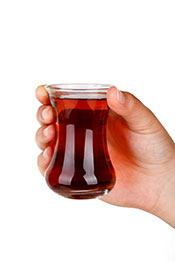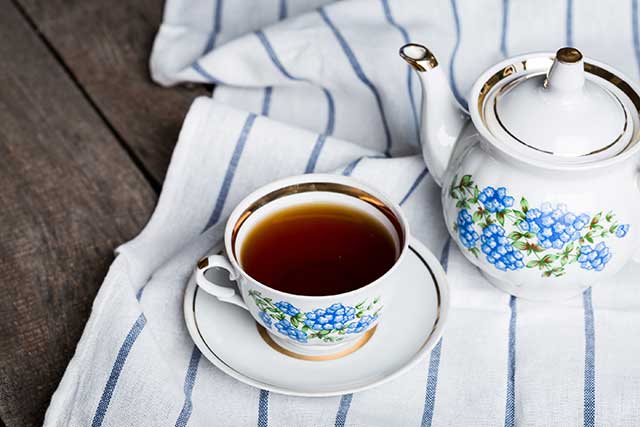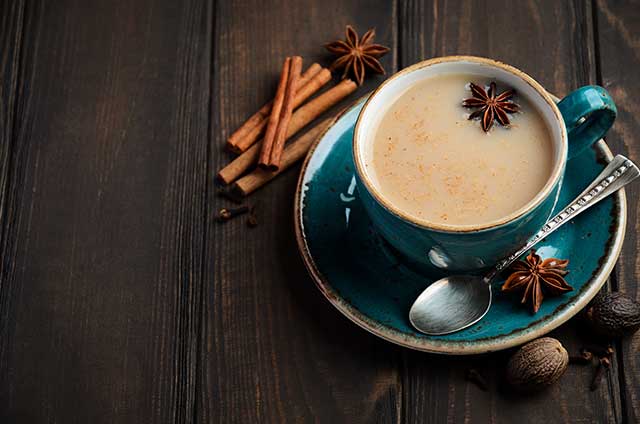 Black tea is one of the healthiest drinks around.
Black tea is one of the healthiest drinks around.
This traditional hot drink has similar benefits to green tea, it contains a wide range of polyphenols, and it can even improve blood sugar regulation (1).
Black tea is also a source of caffeine, containing approximately half the caffeine content of coffee.
So if you are looking for a change from your morning coffee, black tea is an excellent choice.
This article provides a guide on how to make a perfect cup of black tea, and there are some tasty recipes too.
How To Make Perfect Black Tea
Based strictly on my own opinion as a tea lover, here is a guide on how to make a regular black tea taste its best.
Equipment
A tasty cup of black tea requires three things;
- A kettle
- One teapot
- 1 cup per person
- Teapot cozy (this one is optional)
Although teapots are not necessary to make the drink, they help to bring out the best flavor.

Despite this, there are several taste benefits of using a traditional teapot.
The first of these is that using a teapot provides space for the tea leaves to flow around properly, especially when using teabags.
As a result, the tea leaves can all move around, infuse, and contribute to the tea’s flavor.
In contrast, there is not as much space for the tea leaves to move around when brewing tea directly in a cup.
The outcome is that a teapot-brewed cup of tea offers a far greater flavor.
Additionally, using a teapot allows for the brewing of a larger quantity when making tea for one, which can be useful if one cup isn’t enough.
Teapot cozies are optional; they are not so important, but they help to keep the tea as hot as possible.
Preparation Method
- First: Boil some hot water in a kettle (or on the stove); the total amount should be eight fluid ounces (240 ml) per cup.
- Second: When the water starts to boil, pour it into the teapot. Wait for about 15 seconds, and then add one tea bag for each cup. Then add an extra one. For example; use three tea bags for two cups of tea or four tea bags for three cups of tea. After adding the tea bags, put the teapot lid on.
Note: If you are using tea leaves, then two grams is an equivalent amount to one tea bag. The reason for waiting 15 seconds before adding the tea bags is to allow the water to cool slightly to avoid over-extracting the tea’s tannins, which leads to a bitter-tasting tea.
- Third: Let the tea brew for four minutes, and then pour the tea into cups. If you want to drink the tea with milk, add a little milk to each cup and mix with a teaspoon.
Following these instructions should give the most flavorful standard brew of black tea, and brewing in this way tastes so much better than simply using a cup.
Note: The way we brew black tea can either greatly increase or decrease the caffeine content.
For more information, see this guide to caffeine in black tea.
Tasty Black Tea Recipes
If you are looking for something a little different, then here are some recipes for different black tea flavors.
1) Salty Lemon Black Tea
To make this tea, use the following ingredients;
- 8 oz (240 ml) brewed black tea
- 1/4 tsp salt
- 1 tbsp freshly squeezed lemon juice
- One slice of lemon
This slightly sour and mildly salty black tea has a refreshing, flavorful taste.
The salt gets picked up by our tongue’s taste receptors and partly neutralizes the sourness of the lemon, which gives the tea a smoother taste.
2) Vanilla Cream Black Tea
Cream always tastes delicious, but it feels even better with a hint of vanilla.
For this tea, use the following ingredients;
- 8 oz (240 ml) brewed black tea
- 2 tbsp heavy cream
- 1/2 tsp pure vanilla bean extract
- Pinch of cinnamon
- Sweetener (optional)
This hot, creamy vanilla-flavored black tea tastes great, and it is especially satisfying on a cold morning.
If you prefer a sweet taste, add a little of your preferred choice of sweetener.
3) Strong and Spicy Black Tea
If you prefer something a little stronger, then here is a recipe for a bold and spicy black tea.
This one probably isn’t for everyone, but it has a unique flavor.
- 8 oz (240 ml) brewed black tea
- 1/2 tsp cinnamon
- 1/2 tsp ginger
- 1/2 tsp nutmeg
- 1/4 tsp cloves
- 1/4 tsp star anise
- Pinch of black pepper
- (Small!) pinch of cayenne pepper
For those who don’t like things to taste too strong, omit the cayenne pepper, cut the ginger and nutmeg down to 1/4 tsp servings, and add a tablespoon or two of milk/cream.
On the other hand, if you like things spicy, increase all the 1/4 teaspoon servings to 1/2 teaspoon, and be (slightly) more liberal with the cayenne.
4) Creamy Coconut Black Tea
For a mild, creamy and somewhat sweet-tasting black tea, give this recipe a try;
- 8 oz (240 ml) brewed black tea
- 4 tbsp coconut cream
- 1/2 tsp cinnamon
- 1/2 tsp allspice
- Sweetener (optional)
Prepare this recipe like a standard brew of black tea, but pour the tea into a blender at the end.
Next, add the coconut cream, spices, and optional sweetener, and then blend everything.
This drink is very creamy, smooth to drink, and it has a slightly sweet taste.
How Do Different Countries Prepare Their Black Tea?
Finally, let’s take a quick look at how several different countries prepare their black tea;
- China: The Chinese prefer their black tea straight; just pure black tea with nothing added and nothing taken away.
- India and Pakistan: Masala chai is one of the national favorites in these South Asian countries. The tea offers a creamy and mildly spicy taste, and it is often heavily sweetened.
- Japan and Korea: While green tea dominates tea sales in the Far East, it is not difficult to find black tea in this part of the world. Black “Royal Milk” tea latte is a popular (and rather sweet) option in both countries.
- Russia: Black tea is very popular in Russia, and the locals like to drink a strong black brew with nothing to dilute the taste.
- Taiwan: Taiwan is the home of ‘Bubble tea’; sweetened black tea mixed with milk and filled with chewy jelly balls made from tapioca starch.
- Tibet: Before ‘Bulletproof Coffee’ became a thing, Tibetans were putting butter in their black tea for centuries. The tea has the name of ‘po cha,’ which translates directly to “butter tea” in English. This Tibetan drink is an interesting mix of black tea, yak butter, and salt.
- The United Kingdom: Black tea is a hugely popular part of the UK’s culture, and almost everybody drinks it. Some people drink black tea by itself, but this is the exception rather than the norm. Tea is almost always served with a small amount of milk, and a teaspoon (or two) of sugar is optional.
- The United States: Although black tea’s popularity level does not come close to its position in the UK or Ireland, black tea is easy to find in the US. Different states have their own tea cultures, but more often than not the tea is served black. The tea is often sweetened with sugar or syrup, and sweet iced tea is a favorite drink in the summertime.
- Turkey: If you didn’t already know, then Turkey is the world’s number one consumer of black tea per capita. The drink enjoys immense popularity here, and the most popular variety is known as ‘Cay tea.’ Cay is a dark, savory black tea served in a tall glass with ice. I’m not sure about nationwide, but it is available everywhere in Istanbul, and it almost seems as though people drink it like water.
Final Thoughts
Black tea enjoys popularity around the world, and each country has its own unique way of making/serving it.
It is a delicious and healthy drink that many people enjoy, but the way we prepare it can significantly change the taste profile.
If you haven’t tried brewing tea in the traditional (teapot) fashion, then you won’t be disappointed.
For more on tea, see this guide to oolong tea.

